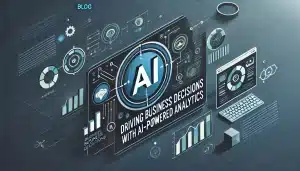In the data-driven age of today, businesses are increasingly turning to AI-powered analytics to gain a competitive edge, streamline operations, and enhance decision-making processes. Artificial intelligence has transformed traditional analytics, introducing sophisticated capabilities that allow businesses to not only analyze vast amounts of data but also extract actionable insights more efficiently than ever before. This blog explores the transformative impact of AI-powered analytics on business decision-making, illustrating key applications, benefits, and considerations for integration. So, let us start learning!
What is AI-powered analytics?
The term simply implies analytics which involves the use of advanced algorithms and machine learning techniques to analyze data and provide insights. This form of analytics can process real-time data analysis, learn from patterns, and make predictions that are beyond human capabilities. AI enhances various types of analytics, mainly including prescriptive, descriptive, and predictive analytics, turning raw data into valuable insights.

Transforming Data-Driven Decision-Making in Various Industries
AI is revolutionizing data-driven decision-making across industries, enabling deeper insights and more accurate predictions than ever before. From healthcare to finance, companies are leveraging AI to optimize operations, enhance customer experiences, and drive innovation. Let’s dig deeper!
1. AI in Retail: In retail, AI analytics help companies predict future trends, understand customer preferences, and manage inventory more effectively. For example, machine learning models can predict seasonal fluctuations in product demand, allowing retailers to optimize their stock levels and minimize overstock or understock situations.
2. AI in Healthcare: AI-driven analytics in healthcare can predict patient outcomes, personalize treatment plans, and streamline operations. By analyzing medical records and real-time health data, AI can identify potential health risks and suggest preventative measures or more tailored treatments.
3. AI in Financial Services: In finance, AI analytics are used for risk assessment, fraud detection, and customer financial behavior analysis. AI systems can analyze transaction patterns to identify unusual behavior that may indicate fraud, significantly reducing losses and improving security.
4. AI in Manufacturing: AI in manufacturing analytics can predict equipment failures and streamline production processes. By analyzing data from machine sensors, AI can identify signs of wear and predict when maintenance is needed, reducing downtime and maintenance costs.
Expanding the Scope: Additional Industries Benefiting from AI Analytics
Well, the scope doesn’t end there! Here are a few more industries that have benefitted from powerful analytics offered with the help of AI.
5. Marketing: AI analytics are revolutionizing marketing strategies by enabling more precise customer segmentation and targeted advertising. AI tools analyze consumer behavior, preferences, and engagement across digital platforms to tailor marketing efforts that are more likely to result in conversion.
6. Transportation and Logistics: In transportation, AI helps optimize routes and schedules, predict maintenance needs, and enhance supply chain efficiencies. Logistics companies use AI to predict delays, optimize shipping routes based on real-time traffic and weather conditions, and manage fleet operations more effectively.
7. Energy Sector: AI applications in the energy sector include forecasting energy demand and optimizing grid operations. AI-driven models can predict peak demand periods and adjust energy supply accordingly, reducing waste and increasing efficiency.
Key Benefits of AI-Powered Analytics
AI-powered analytics are transforming how businesses approach data, offering profound insights that drive smarter decision-making and operational efficiency. These advanced systems can process vast amounts of information in real-time, uncover hidden patterns, and predict future trends, providing a significant competitive edge. Let’s explore the key benefits of integrating AI-driven analytics into your business strategy.
1. Enhanced Efficiency: AI analytics automate the processing and analysis of large data sets, delivering faster insights than traditional methods. This speed allows businesses to react quickly to market changes and internal dynamics.
2. Improved Accuracy: By learning from data, AI models minimize human error and bias, leading to more accurate analyses and predictions. This accuracy is crucial for making reliable business decisions.
3. Scalability: AI systems can easily scale to handle larger data sets as businesses grow, ensuring that analytics capabilities grow with the company without a corresponding increase in operational costs.
4. Proactive Decision Making: With predictive analytics, businesses can anticipate problems and opportunities ahead of time, allowing for proactive rather than reactive strategies.
AI Integration Challenges and Considerations
Integrating AI into business operations presents a unique set of challenges and considerations that organizations must navigate to harness its full potential. From ensuring data quality and managing privacy concerns to adapting organizational culture and securing buy-in from stakeholders, the path to successful AI implementation is complex but rewarding. This discussion aims to shed light on these hurdles and offer strategic insights for effective AI integration.
Data Quality and Quantity:
AI models require large volumes of high-quality data to train effectively. Poor data quality can lead to inaccurate predictions and insights, compromising the reliability of AI systems. Organizations need to establish robust data governance frameworks to continually improve the quality, accuracy, and volume of the data they collect and use.
Privacy and Security:
As AI systems handle sensitive data, ensuring privacy and security is paramount. Businesses must comply with data protection regulations such as GDPR and ensure that their AI systems are secure against cyber threats. This involves implementing advanced security protocols and continuously monitoring data access and usage.
Ethical Considerations:
The use of AI in decision-making processes must be governed by ethical guidelines to prevent biases and ensure fairness, particularly in sensitive sectors like healthcare and finance. Establishing clear ethical standards and guidelines for AI deployment is crucial to maintaining trust and integrity in AI applications.
Integration Complexity:
Integrating AI analytics into existing business systems can be complex and may require significant changes to IT infrastructure and business processes. Businesses must carefully plan the integration process, involving IT specialists and data scientists to ensure seamless compatibility and functionality of AI systems with existing technologies.
Cultural Adaptation:
AI implementation often demands significant cultural shifts within an organization. Employees may need to adapt to new roles or change their approach to work, which can be met with resistance. Effective change management strategies are essential to facilitate these transitions and encourage a culture that embraces technological advancements.
Stakeholder Buy-In:
Securing support from all levels of the organization, especially from senior management, is vital for the successful implementation of AI. Demonstrating the tangible benefits of AI in improving efficiency, reducing costs, or enhancing service quality can help in gaining the necessary buy-in.
Skill Gap:
There is often a skill gap in organizations that hampers the effective adoption of AI. Investing in training programs to upskill employees and hiring new talent with expertise in AI and machine learning can address this issue, ensuring that the workforce is prepared to work alongside advanced AI systems.
Continuous Improvement and Monitoring:
AI systems are not set-and-forget solutions. They require ongoing monitoring, maintenance, and fine-tuning to adapt to new data and changing environments. Establishing a dedicated AI management team can ensure that AI systems evolve in line with organizational needs and continue to provide value.
By addressing these challenges and considerations, businesses can position themselves to fully leverage the transformative power of AI, leading to enhanced operational efficiencies, improved decision-making, and competitive advantages in their respective industries.
Wrapping Up
AI-powered analytics are reshaping how businesses approach decision-making, offering profound advantages in speed, efficiency, and accuracy. As AI technology continues to advance, its integration into business analytics will likely become more prevalent, driving innovation and competitive advantage across all industries. For businesses looking to stay ahead, investing in AI-powered analytics is not just an option; it’s imperative for future success. This transformation, however, requires careful consideration of the challenges and ethical implications associated with AI technologies.
FAQs
1. What is AI-powered analytics?
AI-powered analytics refers to the use of advanced algorithms and machine learning to analyze data and yield actionable insights. It allows businesses to process real-time data with pattern identification and prediction beyond the human mind’s capacity.
2. How does AI improve decision-making?
AI enhances the decision-making process by bringing forth accurate, data-driven insights at a faster speed. It detects trends, predicts future outcomes, discovers patterns in data that humans may not easily recognize, and empowers businesses to make informed, proactive decisions.
3. What industries benefit from AI-powered analytics?
AI analytics is transforming several industries ranging from retail to healthcare, finance, manufacturing, marketing, transportation, logistics, and energy. Each industry benefits in the following ways: increasing efficiency, predicting trends, and optimizing operations.


